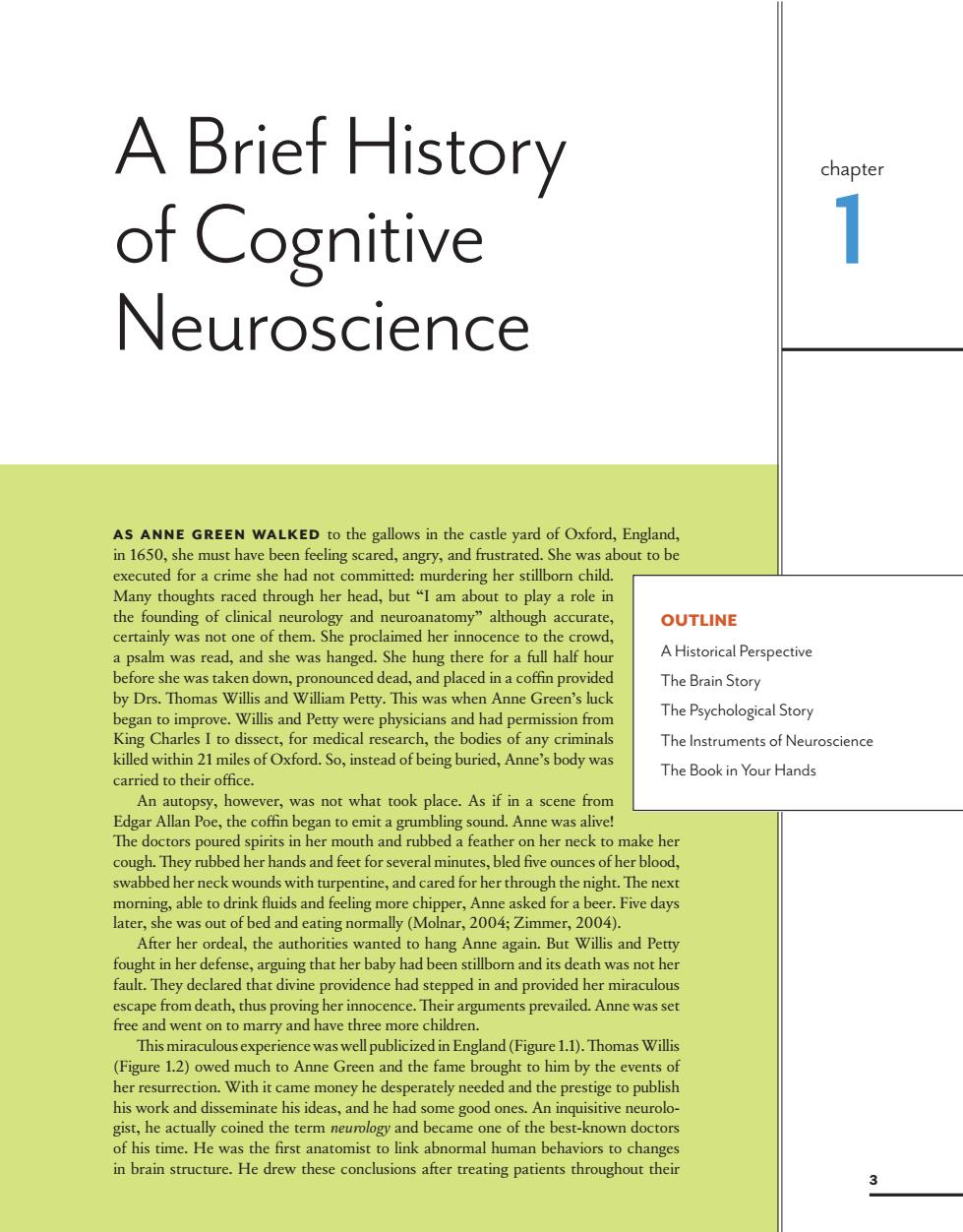正在加载图片...

A Brief History chapter of Cognitive 1 Neuroscience AS ANNE GREEN WALKED to the gallows in the castle yard of Oxford,England. in 1650,she must have been feeling scared,angry,and frustrated.She was about to be executed for a crime she had not committed:murdering her stillborn child. Many thoughts raced through her head,but"I am about to play a role in OUTLINE A Historical Perspective The Brain Story s and Green' The Psychological Story The Instruments of Neuroscience killed within 21 milcs ried to their office The Book in Your Hands The docto her mouh and rubbed a feather on her neck tomakehe ugh.They rubbed her hands and feet for sev ral minutes.bled five es of her blood swabbed her neck wounds with tur ntine,and cared for her through the night.The next r,Anne asked for a beer.Five days After her ordeal.the authorities wanted to hang anne again.But willis and petty fought in her defense,arguing that her baby had been stillborn and its death was not her fault.They declared that divine providence had stepped in and provided her miraculous escape from death,thus proving her innocence.Their arguments prevailed.Anne was set free and went on to marry and have three more children This miraculousexperience was wellpublicized in England (Figure 1.1).Thomas Willis (Figure 1.2)owed much to Anne Green and the fame brought to him by the events of r resurrection.With it came money he desperately needed and the prestige to publish and disscminate his ideas,and he nadese nro st-Known h ne term neurology and 3 1 chapter A S A N N E G R E E N WA L K E D to the gallows in the castle yard of Oxford, England, in 1650, she must have bee n fee ling scared, angry, and fr ustrated. She was about to be executed for a crime she had not committ ed: murdering her stillborn child. Many thoughts raced through her head, but “I am about to play a role in the founding of clinical neurology and neuroanatomy” although accurate, certainly was not one of them. She proclaimed her innocence to the crowd, a psalm was read, and she was hanged. She hung there for a full half hour before she was taken down, pronounced dead, and placed in a coffi n provided by Drs. Th omas Willis and William Petty . Th is was when Anne Gree n’s luck began to improve. Willis and Petty were physicians and had permission fr om King Charles I to dissect, for medical research, the bodies of any criminals killed within 21 miles of Oxford. So, instead of being buried, Anne’s body was carried to their offi ce. An autopsy, however, was not what took place. As if in a scene fr om Edgar Allan Poe, the coffi n began to emit a grumbling sound. Anne was alive! Th e doctors poured spirits in her mouth and rubbed a feather on her neck to make her cough. Th ey rubbed her hands and fee t for several minutes, bled fi ve ounces of her blood, swabbed her neck wounds with turpentine, and cared for her through the night. Th e next morning, able to drink fl uids and fee ling more chipper, Anne asked for a bee r. Five days later, she was out of bed and eating normally (Molnar, 2004; Zimmer, 2004). Aft er her ordeal, the authorities wanted to hang Anne again. But Willis and Petty fought in her defense, arguing that her baby had bee n stillborn and its death was not her fault. Th ey declared that divine providence had stepped in and provided her miraculous escape fr om death, thus proving her innocence. Th eir arguments prevailed. Anne was set fr ee and went on to marry and have three more children. Th is miraculous experience was well publicized in England (Figure 1.1). Th omas Willis (Figure 1.2) owed much to Anne Gree n and the fame brought to him by the events of her resurrection. With it came money he desperately nee ded and the prestige to publish his work and disseminate his ideas, and he had some good ones. An inquisitive neurologist, he actually coined the term neurology and became one of the best-known doctors of his time. He was the fi rst anatomist to link abnormal human behaviors to changes in brain structure. He drew these conclusions aft er treating patients throughout their A Brief History of Cognitive Neuroscience OUTLINE A Historical Perspective The Brain Story The Psychological Story The Instruments of Neuroscience The Book in Your Hands 002_021_CogNeu_4e_Ch01.indd 3 8/2/13 9:12 AM